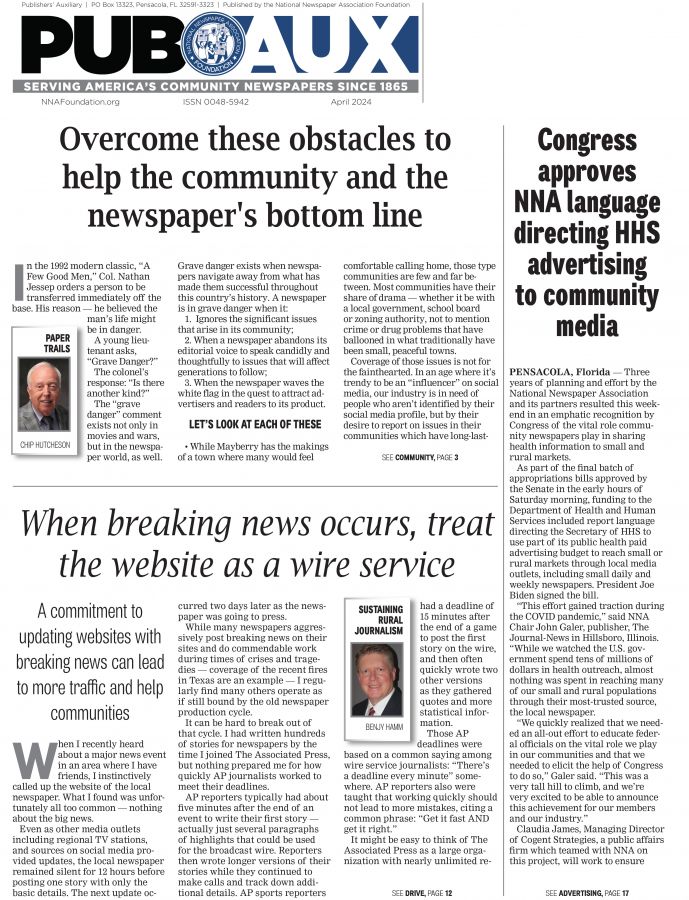U.S. Supreme Court opinions are final—or are they?
Jul 8, 2014
By Tonda F. Rush
CEO | NNA
Another myth dies.
So you might call me a casehardened Washington lawyer. In my 34-year career in Washington, I have witnessed two government shutdowns; hearings for good presidential nominees torched by partisan politics; self-destructive, illogical votes by politicians afraid of the wings of their own party and deceptions ranging from mild to eye-popping.
I thought I was a hard person to shock.
But the New York Times managed it on May 25 when it revealed that the U.S. Supreme Court changes its opinions after they are announced, sometimes a very long while later.
Not only that, but it provides no public notice that the opinions were changed. To catch the justices in the act, you must comb line by line through whichever version you have been using and compare it to whichever version is considered the latest—which may or may not be the one on the Court’s website, a medium often slow to update.
The changes are not just cosmetic. Justice Antonin Scalia revised an opinion in an EPA case after he misstated the agency’s position in an earlier case. Justice Sandra Day O’Connor deleted a whole sentence where she said Scalia had agreed with a portion of her reasoning in a Texas sodomy case. Justice Elena Kagan fixed her mistake in misstating the location of the first community of American Jews.
It is not hard to imagine a justice’s updating an earlier viewpoint when the tide of public opinion turns against him or her, or when the hard eye of history gazes on an opinion’s flaws.
In an industry often accused of scrambling for the beat on a story at the cost of accuracy, newspaper folks may be nonplussed to learn that the court publishes its work before it is perfectly vetted. This haste discourages defections from justices inclined to second-guess their own early positions and destroy the thin majority in a 5-4 vote so common on the Court today.
Legal publishers, like Lexis and WestLaw, apparently receive access to “change” pages that show all revisions. But the court does not make those public. It refused to provide them to the Times.
At least scholars with the patience for line-by-line comparisons can still find a true copy in the printed case reporter books. At least that version is always reliable at the court’s opinion, fixed in time. Those printed books do contain errata to correct simple errors.
But for how much longer?
That comforting fixed authority is under attack, just as it is in public notices.
There is a common thread in these two New Age of challenges to the value of paper copies. In both cases, the pressure is heavy to eliminate the printed copy and to claim electronic version is cheaper, although the claims routinely omit the cost of the public servants involved in creating and maintaining the digital version, and they overlook the future need to fund electronic updates and revisions as software and systems change and to keep archives of the older versions, a need not necessary for preservation of paper records.
But no matter. So painfully eager to seem in sync with the digital revolution, several states are already on the road to wipe out their printed legal history through the adoption of a new proposed uniform state law called the Uniform Electronic Legal Materials Act. The law would not only permit states to abandon printed law books; it would immunize states from lawsuit if it turned out the electronic record was just plain wrong. The burden to prove inaccuracy rests upon the challenger.
Same problem with public notices. Legislative proponents of eliminating the published print copy trumpet their belief that print is dead and the ultimate of cool is digital. It can take a lot of talking to persuade them that a digital-only public notice can be vaporized as easily as, well, an old Supreme Court opinion.
Such an argument to make! If we can’t count on the Supreme Court, highest law of the land, to keep the faith with authenticity, whom can we trust?
We can trust the printed copy. At least once it is printed, it is done. The author may elaborate, expound, revise and correct in later publications but he cannot rewrite history.
Newspapers have long leaned on the four supporting poles of transparency embodied in newspaper public notices. Public notices are accessible, authenticated, archived and independent of the entity charged with giving notice. Our industry is well versed now in the first and last of these. We know how inaccessible electronic notices are in a nation where the intractable digital divide means that a third of the citizens cannot or will not receive them. And the value of independence needs no elaboration in the culture of the free press.
Maybe the Supreme Court will help our legislatures finally to understand the middle two. If it does, the lesson must come within the admission that when you can’t trust the electronic copy, you have to trust the authors and custodians. And sometimes you can trust neither. Not even when they are the nine people sworn to preserve and protect the law of the land.







